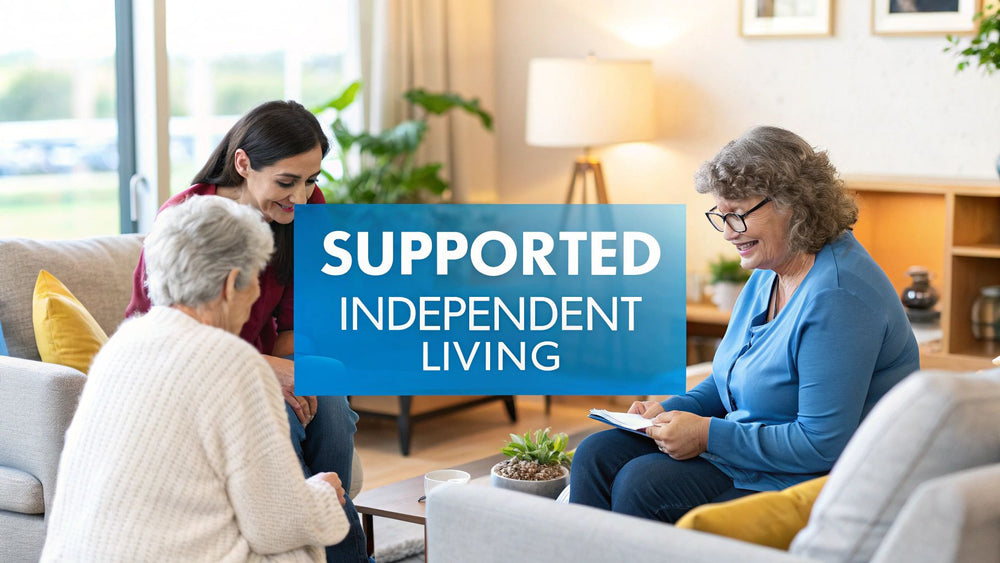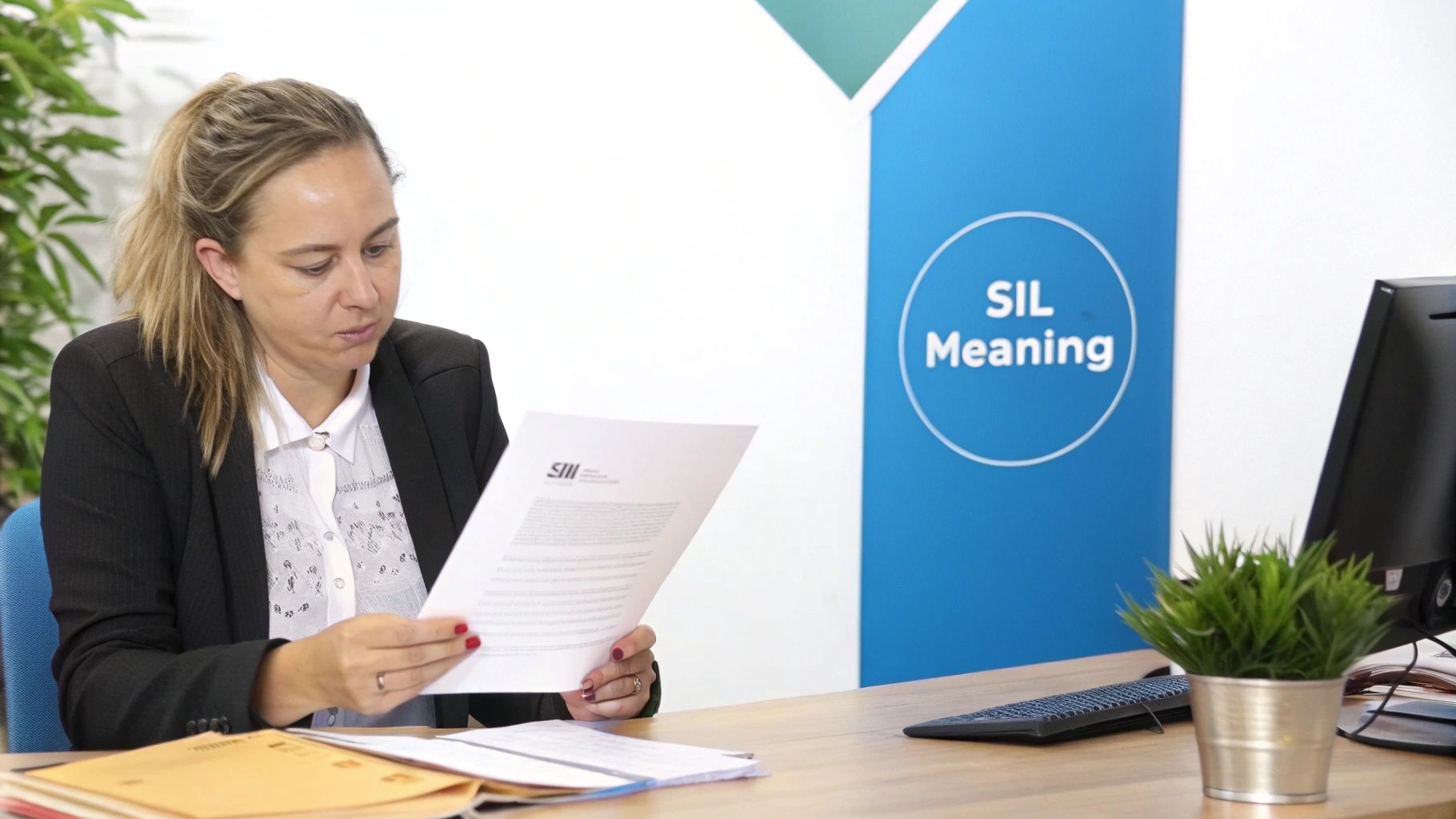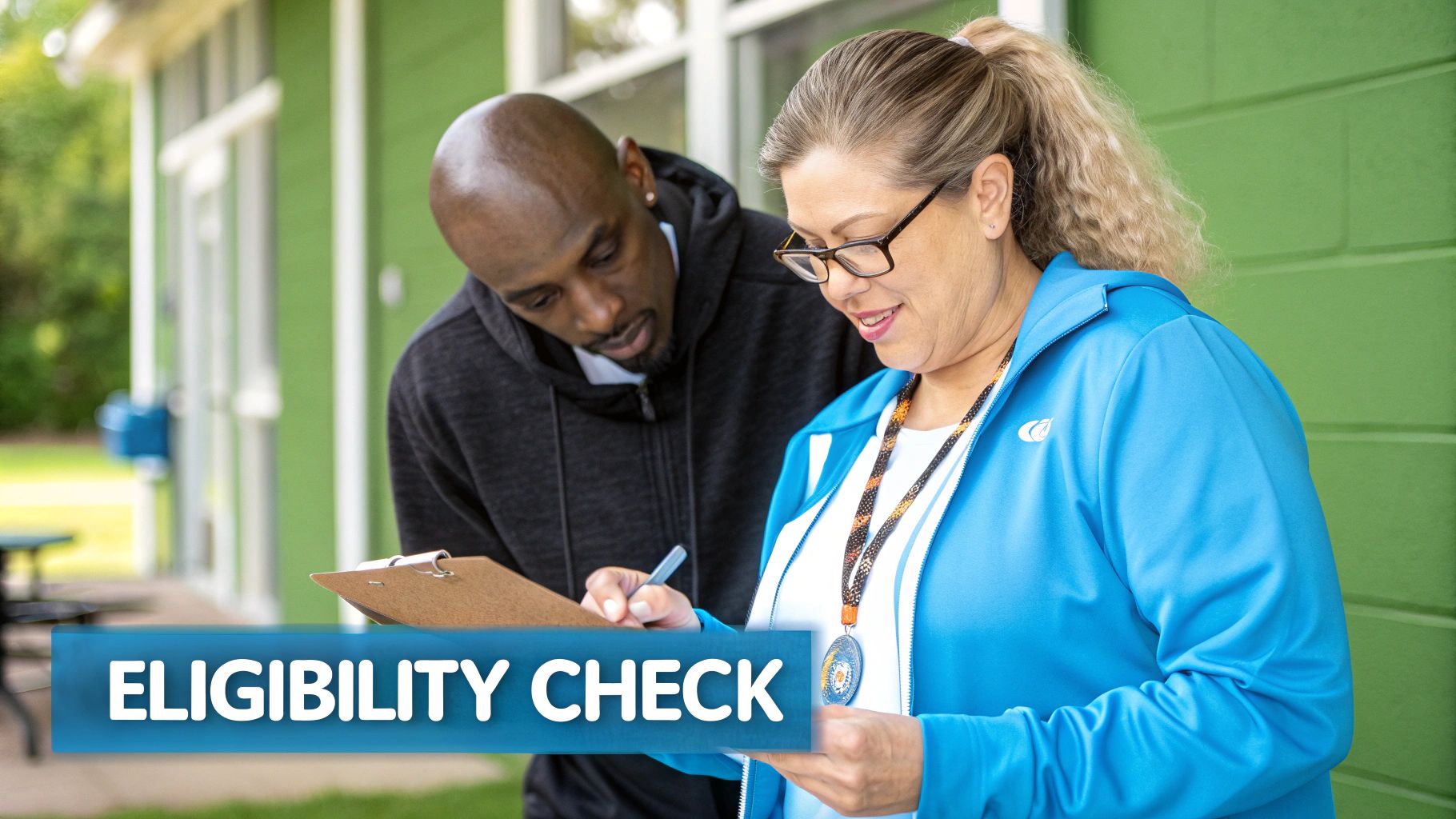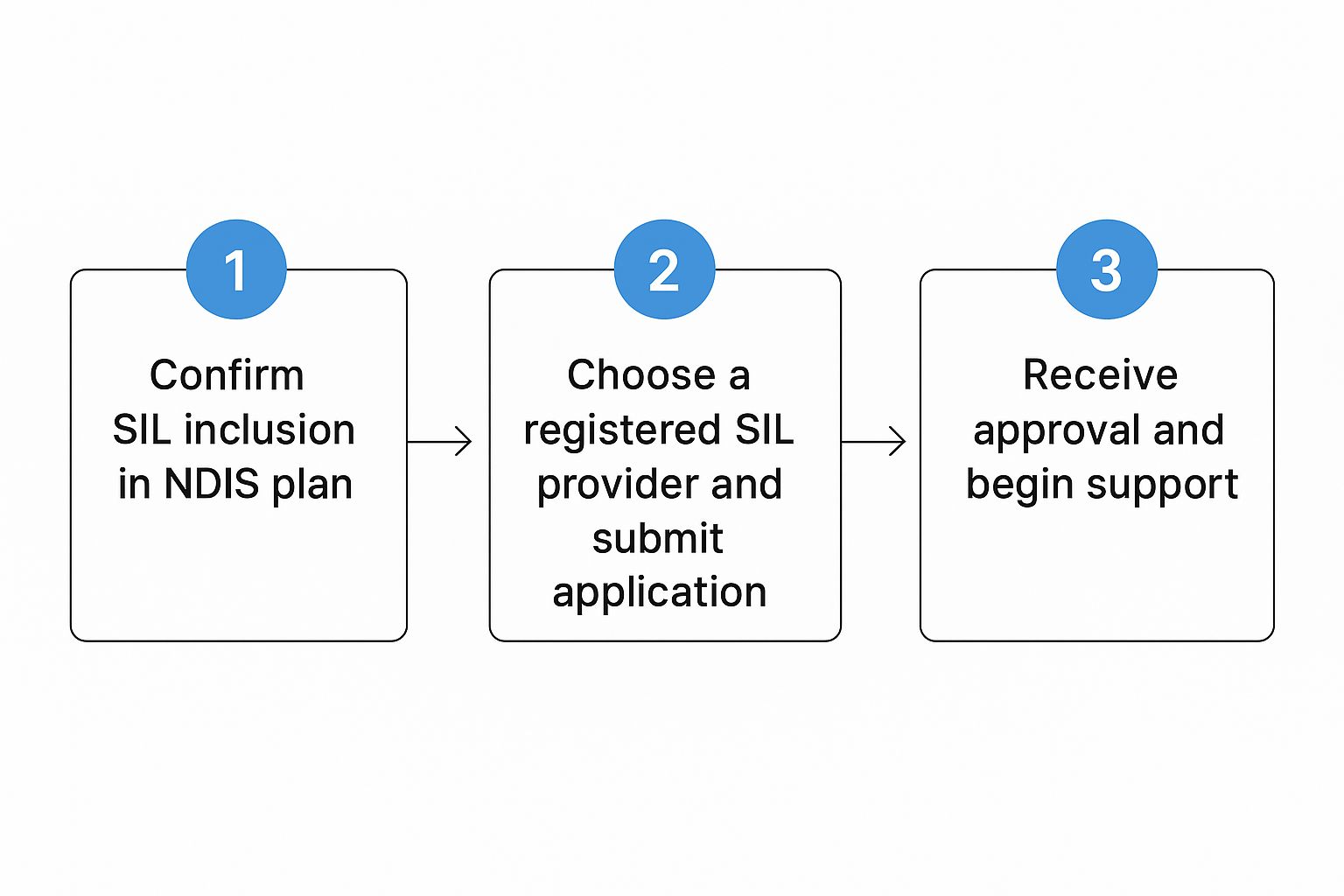What Does SIL Stand for NDIS? A Complete Guide

If you’re starting to explore the National Disability Insurance Scheme (NDIS), you’ll almost certainly come across the acronym SIL. So, what exactly is it?
Simply put, SIL stands for Supported Independent Living. It’s a specific kind of NDIS funding designed to give you the daily support you need to live as independently as possible, whether that’s in your own home or in a shared living arrangement.
Unpacking Supported Independent Living

It’s a common point of confusion, but the most important thing to remember is that SIL is about the people providing support, not the bricks and mortar of the place you live.
Think of it as having a dedicated 'life skills crew' on your side. Their whole focus is to help you with day-to-day tasks and build your skills, right there in your own home. This moves away from older, institutional models of care and puts the power back in your hands, giving you real choice and control over how you want to live.
What Does This Support Look Like in Practice?
SIL funding is all about practical, hands-on help. It’s for NDIS participants who need a significant level of support with everyday tasks. This assistance could be for a few hours each day or even 24/7 care, depending entirely on your unique circumstances and what’s outlined in your NDIS plan.
This support can cover a wide range of activities, including:
- Daily household tasks like preparing meals, doing the laundry, and keeping your home clean.
- Personal care routines such as help with showering, getting dressed, or managing medications.
- Building life skills like learning how to budget, do the grocery shopping, or catch public transport.
- Connecting with your community by getting you to appointments, social outings, or activities you love.
The real aim of SIL is to provide just the right amount of support to help you grow your skills, boost your confidence, and live life on your own terms. It’s about creating a solid foundation for true independence.
To make this distinction crystal clear, here’s a quick breakdown of what SIL funding does and doesn't cover.
SIL at a Glance: What It Is vs What It Is Not
| SIL Funding Covers (The Support) | SIL Funding Does Not Cover (The Place) |
|---|---|
| Support with personal care | Rent or mortgage payments |
| Help with cooking and cleaning | Groceries and household supplies |
| Building skills like budgeting | Utility bills (electricity, water, gas) |
| Assistance with daily tasks | Home modifications or repairs |
| Support to access the community | Day-to-day living expenses |
As you can see, SIL is purely focused on funding the support workers who help you live independently. The other costs associated with housing, like rent and bills, are separate.
Understanding how SIL works is the first step in advocating for the right supports in your NDIS plan. To dive even deeper, have a look at our complete guide on what is Supported Independent Living and how it can be personalised for you.
Who Qualifies for SIL Funding?

Navigating NDIS funding can feel like a maze, so let's break down who Supported Independent Living (SIL) is really for. In simple terms, SIL is designed for NDIS participants with high support needs—that is, people who need quite a bit of help, sometimes around the clock, to manage daily life on their own terms.
It’s less about ticking boxes and more about painting a clear picture of your day-to-day reality. Your eligibility isn’t just based on your disability itself, but on how it specifically impacts your ability to handle everyday tasks. This is all determined through a functional assessment that looks at your unique situation.
For instance, you might be a good candidate if you need hands-on help with personal care like showering or getting dressed, or if you require significant support with cooking, managing your home, or keeping on top of complex health needs, day or night.
Key Factors in Determining Eligibility
The National Disability Insurance Agency (NDIA) needs to see that SIL is a "reasonable and necessary" support for you. To do this, they’ll look for solid evidence showing a clear need for things like:
- Significant Personal Care: You require active, hands-on assistance with most or all of your personal care routines.
- Complex Needs Management: You need help to correctly manage medications, get to health appointments, or navigate challenging behaviours.
- Skill Development: You have a goal to become more independent, and SIL provides the safe, supportive environment you need to learn and practise those new skills.
At its core, the assessment has to demonstrate that without this level of dedicated support, you simply wouldn’t be able to live safely or independently in your own home or community.
SIL is a critical support pathway for many Australians with intellectual disabilities, especially those with histories of institutionalisation or complex care needs. It provides the framework for them to live in the community rather than in more restrictive settings.
This is a really important point, especially when you consider that people with intellectual disabilities represent a huge part of the NDIS. In fact, official figures show that around 27% of all NDIS participants have an intellectual disability as their primary disability, which really highlights how vital SIL funding is.
You can learn more about the importance of SIL for community living on Inclusion Australia and the ongoing discussions around it.
What Support Services Does SIL Actually Fund?

So, when we talk about Supported Independent Living, what does that support actually look like day-to-day? It’s more than just a list of services; it's the practical, hands-on assistance that helps you live your life, your way. This is where the funding in your NDIS plan turns into real-world help that builds both confidence and independence.
Think of it this way. Instead of a vague line item for 'personal care,' picture a support worker helping you with your morning routine so you can start the day feeling great. Rather than just 'skill development,' imagine someone guiding you as you learn to budget for groceries, master a new recipe, or figure out the local bus route to meet up with friends.
Tangible Areas of SIL Support
To get more specific, SIL funding is designed to cover help across several key areas of your life. These are the supports delivered by workers right there in your home, all tailored to your unique goals and needs.
Here are some of the most common things SIL can cover:
- Managing Daily Life at Home: This is all about keeping your home running smoothly. It can include help with planning and cooking meals, cleaning your living areas, and doing the laundry.
- Personal Care Assistance: This is direct support with personal tasks like showering, getting dressed, grooming, or managing your medication, all provided with dignity and respect.
- Building Community Connections: Your support workers can help you get out and about, whether that's for medical appointments, joining a social club, heading to a community event, or just enjoying your hobbies.
- Developing New Life Skills: This is a big one. It's about empowering you to handle more things on your own. You might work on managing your money, learning to use public transport confidently, or improving how you communicate.
The real aim of SIL is to provide the right support at the right time. It’s not about someone doing things for you, but about working with you to build your skills and live the life you want.
For some people with more complex health needs, SIL can also include support from specialised professionals. You can find out more about how this might work by reading up on what is community nursing and the part it can play in home-based support.
Understanding the Difference Between SIL and SDA
Navigating the NDIS can feel like learning a new language, and one of the most common points of confusion is the difference between Supported Independent Living (SIL) and Specialist Disability Accommodation (SDA). But don't worry, the distinction is actually quite simple once you break it down.
Let's use a straightforward analogy: SIL is the support team, and SDA is the specialised building.
SIL funding is for the people—the support workers who help you with daily life. SDA, on the other hand, is funding for the physical home itself—the bricks and mortar designed to meet high accessibility needs.
People vs. Place: An Easy Breakdown
Thinking about it as 'people vs. place' makes it much easier to grasp.
-
SIL (The People): This is the funding that pays for the roster of support. It covers the wages for the team who assist with things like cooking, personal care, managing appointments, or getting involved in the community. It’s all about the human support you receive day-to-day.
-
SDA (The Place): This funding contributes to the cost of the actual building. We’re talking about purpose-built homes with features like automatic doors, reinforced ceilings for hoists, or wheelchair-accessible bathrooms. It's about the physical structure you live in.
It’s crucial to know that you can have one without the other. You might have SIL funding to get support in a standard rental home that isn't SDA. However, for NDIS participants with very high support needs, funding for both is common because the specialised home and the support team are designed to work hand-in-hand.
Essentially, the NDIS separates your support services from your housing costs into two distinct funding streams. Supported Independent Living covers the daily support hours and staffing, while SDA covers the physical home environment.
Knowing whether you need help with daily tasks (SIL), an accessible home (SDA), or both is the first step to getting the right support in your NDIS plan. For a deeper dive into this, check out our guide on the key differences between SDA vs SIL.
How to Get SIL Funding in Your NDIS Plan
Getting Supported Independent Living added to your NDIS plan can feel like a big undertaking, but it’s a clear and manageable process once you know the steps. Let's walk through what you need to do to build a strong request.
It all starts with demonstrating to the National Disability Insurance Agency (NDIA) that SIL is a “reasonable and necessary” support for your specific situation. This is more than just saying you want it; you need to provide clear evidence showing how SIL will directly help you live more independently and achieve your personal goals.
Gathering Your Evidence
To make a convincing case, you’ll need to pull together a few key professional reports. Think of these documents as the foundation of your funding request.
The most important reports include:
- Functional Capacity Assessments (FCAs): An Occupational Therapist (OT) usually prepares this. It’s a detailed report that outlines your day-to-day abilities, the challenges you face, and provides a professional opinion on the exact support you need.
- Reports from Allied Health Professionals: This could be letters or assessments from your psychologist, physiotherapist, or speech pathologist. These add weight to your application by confirming your need for specific, specialised support.
Together, these documents paint a comprehensive picture for the NDIA, explaining exactly why the level of support SIL offers is right for you. Putting all this together can be tricky, which is where a Support Coordinator can be invaluable. You can learn more about the essential role of support coordination and how they help manage this process.
The Roster of Care Explained
With your evidence ready, the next step is creating a Roster of Care (ROC). It sounds technical, but it’s essentially a detailed weekly timetable of your support.
A Roster of Care maps out a typical week, hour by hour, detailing precisely when you need support and what kind of help that is. It clearly separates your individual supports from any shared supports with housemates, giving the NDIA the exact data it needs to calculate and approve your funding.
This infographic gives you a high-level look at the SIL application journey.

As you can see, once you’ve confirmed SIL is in your plan, you’ll work with a provider to get the quote and the Roster of Care ready for the NDIA’s final approval.
The Real-World Impact of Supported Independent Living
So, what does Supported Independent Living actually look like in real life, beyond the paperwork and support rosters? The true value of SIL isn’t just about getting help with daily tasks. It’s about unlocking a life filled with dignity, genuine choice, and the space to grow as a person.
For many NDIS participants, SIL is the first real step towards living on their own terms. It could be a young adult moving out of their family home for the first time, finally able to create their own space while knowing support is there when they need it. It might also mean moving from a larger, more structured group home into a setting that truly reflects their personality and preferences.
Growing Confidence and Connecting with Others
At its heart, SIL is about empowerment. When someone learns to cook their favourite meal, manage their own budget, or catch a bus into town, they’re not just learning a skill—they’re building powerful self-confidence. This newfound belief in their own capabilities often spills over into other parts of their life, giving them the courage to build stronger connections in their community.
With the right support structure in place, participants are better able to:
- Join a local club or group based on their hobbies, whether it’s a book club, a gardening group, or a sports team.
- Volunteer for a cause they feel passionate about, allowing them to give back and share their skills.
- Form meaningful friendships with their housemates and neighbours, creating a support network and reducing feelings of isolation.
The real aim of SIL is to build a stable foundation from which people can take control of their lives. It's about creating a safe, supportive environment to try new things, make decisions, and chase a life that feels right for them.
This person-first approach means that support is a partnership, not just a service. You can see what this looks like in practice by reading more about independent living services in SA and how they are shaped around individual goals and dreams.
Got Questions About SIL? We've Got Answers.
It's completely normal to have a few questions floating around after taking in all this information about Supported Independent Living. Let's tackle some of the most common ones to give you a clearer picture.
Can I Choose Who I Live With?
Yes, absolutely. The NDIS is built on the idea of choice and control, and that extends to your home life. You get to have a say in who your housemates are.
A good SIL provider will take this seriously, working hard to match you with people you'll get along with. After all, your home should feel like a safe, positive, and genuinely supportive space.
What if My Support Needs Change?
Life happens, and needs can change. Your NDIS plan is designed to adapt with you.
If you find you need more (or even less) support, you can ask for a plan reassessment with the NDIA. To do this, you’ll need fresh reports from your occupational therapist or other allied health professionals that outline why your funding needs to be adjusted.
A key thing to remember is that SIL funding is specifically for the support services you get from workers. It doesn't cover your day-to-day living costs like rent, groceries, or electricity bills. Those expenses are usually covered by your own income, like the Disability Support Pension (DSP).
Getting your head around these details really helps set you up for a smoother SIL journey.
At Vana Care, our goal is to make the NDIS journey as straightforward as possible. If you’re in Adelaide and have more questions about Supported Independent Living, you can explore our SIL services to see how we can help.


